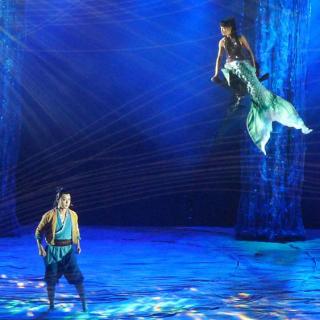
介绍:
"Mermaid at the East Sea", or Dong-Hai-Ren-Yv in Chinese had its debut in 1981. Since then, the China National Theatre for Children has developed it as a classic play, in which the story about a young man from a nearby fishing village in his utmost endeavor to save the mermaid Cai-ping has moved many.
Zhong Hao used to play the kind-hearted young man Jin Zhuzi in 1981. Today, he is director of this upgraded children's drama.
"In the past, the drama was observed with class-consciousness. For example, the dragon king symbolizes the exploiting class. It's a critique on feudalism, but it doesn't relate to nowadays. I want to tell the story from a different angle, which interprets the human nature and emotions. And thus the story-telling process may manifest one's persistent pursuit towards his or her ideals."
In fact, the new development in this play not only touches a different angle from which the tale is recounted, but audience could also be dazzled by the richly-varied backdrops using multi-media technolgy.
According to the director, the stage is entirely paved with silk-like sand. There is a rotating disk at the centre of the stage, which sometimes changes into a round of turbulent sea waves, while other times is turned into a mountain path.
As audience members all feel impressed by a dreamlike world of tales, what does the leading actress feel about this sand-paved stage?
Chen Lei, who acts mermaid Cai-ping, provides her opinion:
"I would have to use lots of body language to showcase how a human transforms into a mermaid. It's not an easy job. Also, I have to perform from the beginning till the end with bare feet. With a slope, the stage, which is covered with three layers of sponge, poses challenges to bare-feet performers. Meanwhile, a small area on stage is all sand. During this show, I am hung in mid air. The director has added dreamlike touches to the backdrop, making it appear very aesthetically romantic."
There are two leading men in the play. Jin Zhuzi (金珠子) commits his life to realizing his promise to mermaid Caiping that he would help her regain her legs and return home.
Another boy called Wu Zhenbao, however, is a mischief maker. Director Zhong Hao discloses how he has fortified the contrast between the two leading men.
"I want to compare the two kids. One is idealistic while the other is realistic. The impact their families have on them respectively makes them differ greatly in personality. In the play, their relationship and their differences is highlighted to strike out the contrast. In the 1981 show, Jin Zhuzi eventually got too old to save mermaid. I've adapted the script for the ongoing show in which Wu Zhenbao gets old too."
Folklore has it that mermaid tears may turn into pearls upon contact with air and could bring a dying person back to life. The play also includes this interesting myth, which gives a good explanation to how Jin Zhuzi meets mermaid Caiping when the young boy is picking up seashells.
"Mermaid at the East Sea" is one of many legends about the mythical mermaids. Hans Christian Andersen's well-known fairy tale "The Little Mermaid" was created a lot earlier. And also the mermaids have subsequently been depicted in operas, paintings, books and films.
Chen Lei compares the values interpreted from mermaids in Chinese and western mythology.
"The Little Mermaid story is a prevailing culture before our "Mermaid at the East Sea". Everyone knows that story is about an immortal soul. However our play is not only about a kind girl who is willing to sacrifice, but her spirit of total devotion who influences others that are willing to sacrifice their own lives to save her. It's a traditional virtue of Chinese people that our play is hoping to convey."
Since the play "Mermaid at the East Sea" opened the 5th China Children's Theatre Festival recently, the festival, which will run until August 26th, would undoubtedly enrich domestic young audiences' life by presenting 200 shows.
For Studio Plus, I'm Xu Fei.
大家还在听

